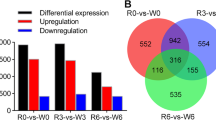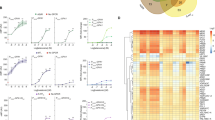Abstract
The heterothallic species of the agricultural pest Phytophthora use mating hormones α1 and α2 to regulate their sexual reproduction. Here we describe the absolute stereostructure of the second mating hormone α2 as defined by spectroscopic analysis and total synthesis. We have uncovered not only the interspecies universality of α hormones but also the pathway by which α2 is biosynthesized from phytol by A2–mating type strains and metabolized to α1 by A1 strains.
This is a preview of subscription content, access via your institution
Access options
Subscribe to this journal
Receive 12 print issues and online access
$259.00 per year
only $21.58 per issue
Buy this article
- Purchase on Springer Link
- Instant access to full article PDF
Prices may be subject to local taxes which are calculated during checkout


Similar content being viewed by others
References
Erwin, D.C. & Ribeiro, O.K. Phytophthora Diseases Worldwide (APS, St. Paul, Minnesota, USA, 1996).
Fry, W.E. & Goodwin, S.B. Bioscience 47, 363–371 (1997).
Judelson, H.S. & Blanco, F.A. Nat. Rev. Microbiol. 3, 47–58 (2005).
Fry, W. Mol. Plant Pathol. 9, 385–402 (2008).
Rizzo, D.M., Garbelotto, M., Davidson, J.M., Slaughter, G.W. & Koike, S.T. Plant Dis. 86, 205–214 (2002).
Savage, E.J. et al. Phytopathology 58, 1004–1021 (1968).
Ashby, S.F. Trans. Br. Mycol. Soc. 14, 18–38 (1929).
Ko, W.H. J. Gen. Microbiol. 107, 15–18 (1978).
Ko, W.H. Bot. Stud. (Taipei, Taiwan) 48, 365–375 (2007).
Chern, L.L., Tang, C.S. & Ko, W.H. Bot. Bull. Acad. Sin. 40, 79–85 (1999).
Chern, L.L., Ko, W.H. & Tang, C.S. Can. J. Microbiol. 42, 172–176 (1996).
Ko, W.H. J. Gen. Microbiol. 129, 1397–1401 (1983).
Qi, J. et al. Science 309, 1828 (2005).
Yajima, A. et al. Nat. Chem. Biol. 4, 235–237 (2008).
Harutyunyan, S.R. et al. Proc. Natl. Acad. Sci. USA 105, 8507–8512 (2008).
Wang, S.Y. Org. Lett. 12, 5166–5169 (2010).
Bajpai, R., Yang, F. & Curran, D.P. Tetrahedr. Lett. 48, 7965–7968 (2007).
Yajima, A. et al. Tetrahedr. Lett. 48, 4601–4603 (2007).
Ko, W.H. Annu. Rev. Phytopathol. 26, 57–73 (1988).
Jee, H.J. & Ko, W.H. Mycol. Res. 101, 1140–1144 (1997).
Jee, H.J., Tang, C.S. & Ko, W.H. Bot. Bull. Acad. Sin. 43, 203–210 (2002).
Peisker, C., Düggelin, T., Rentsch, D. & Matile, P. J. Plant Physiol. 135, 428–432 (1989).
Tyler, B.M. et al. Science 313, 1261–1266 (2006).
Haas, B.J. et al. Nature 461, 393–398 (2009).
Shibata, Y., Kawakita, K. & Takemoto, D. Mol. Plant Microbe Interact. 23, 1130–1142 (2010).
Acknowledgements
We thank K. Kawakita for P. infestans strains and W.H. Ko for valuable suggestions. This work was supported by Grants-in-Aid for Scientific Research from Japan Society for the Promotion of Science (22248012, 21710239 and 18380073). S.D.M. is a recipient of a Japanese Ministry of Education, Culture, Sports, Science and Technology (MEXT) scholarship (080028).
Author information
Authors and Affiliations
Contributions
M.O. designed the project and wrote the manuscript; S.D.M. isolated 2, tested hormone response and prepared the manuscript; H.K. isolated 2; A.Y., K.T. and T.N. performed chemical syntheses; H.M. did isotope-labeled experiments; R.M. contributed to LC/MS analysis; T.A. contributed to bioassay; J.Q. isolated 1; and Y.S. designed the project.
Corresponding author
Ethics declarations
Competing interests
The authors declare no competing financial interests.
Supplementary information
Supplementary Text and Figures
Supplementary Methods and Supplementary Results (PDF 1449 kb)
Rights and permissions
About this article
Cite this article
Ojika, M., Molli, S., Kanazawa, H. et al. The second Phytophthora mating hormone defines interspecies biosynthetic crosstalk. Nat Chem Biol 7, 591–593 (2011). https://doi.org/10.1038/nchembio.617
Received:
Accepted:
Published:
Issue Date:
DOI: https://doi.org/10.1038/nchembio.617
This article is cited by
-
Evaluation of PCR markers for Phytophthora infestans mating type determination
European Journal of Plant Pathology (2018)
-
Specific Inhibitors of Sporangium Formation of Phytophthora capsici from Kalimeris indica
Chemistry of Natural Compounds (2018)
-
Universality of the Phytophthora mating hormones and diversity of their production profile
Scientific Reports (2017)
-
Celebrating synthesis
Nature Chemical Biology (2011)



